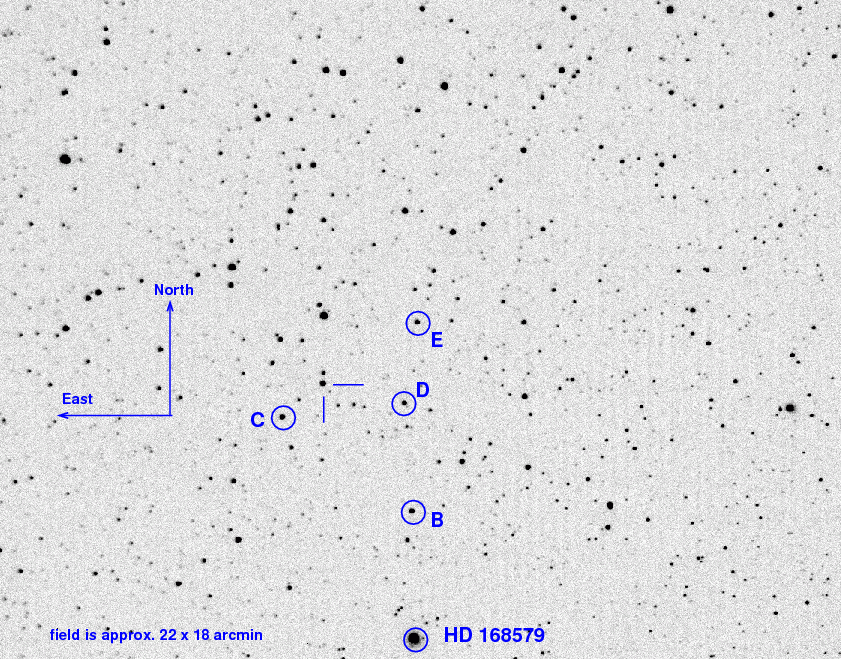
On the night of Jun 28/29, 2018, from about 10:30 PM until dawn, through mostly clear, occasionally cloudy, and brightly moonlit skies, I acquired a set of observations of the likely black-hole system MAXIJ1820+070, (also known as ASASSN-18ey ).
I turned alt knob 1/2 notch CW, and overshot the proper position. Next time, try small adjustment CCW, but watch TV screen to account for slippage when I loosen and tighten the bolts.
The main setup was:
Notes from the night:
This optical and X-ray and radio transient is likely a black hole accreting material at a higher-than-usual rate. It has been the subject of many observers over the past few months -- see the trail of telegrams that include
The object is located at
RA = 18:20:21.9 Dec = +07:11:07.3
A chart of the field is shown below. The size of the chart is about 22 by 18 arcminutes.
I've marked the location of several comparison stars, which also appear in light curves below. Stars C, D, and E are mentioned by the Tomoe Gozen team in ATel 11426, but all three are rather red, with (B-V) ranging from 1.14 to 1.37. Star B is one of the bluest nearby bright stars, with (B-V) = 0.52.
star UCAC4 B V ---------------------------------------------------- B 486-079513 12.975 12.454 C 486-079608 13.968 12.830 D 486-079523 14.637 13.272 E 487-077858 14.637 13.272 ----------------------------------------------------
The dark current was ordinary, but note the warmer than usual camera temperature of -16 C.

The sky value shows clouds early and late, with clear skies surrounding those periods. The small sharp increases are due to moonlight striking the front of the telescope (I think), then disappearing as the dome slit blocked it.

Here's a record of the telescope's drift. At the start of the night, I turned the altitude knob 0.5 notches CW, and overshot the proper position: the stars now drift North when the telescope points west, instead of drifting South.

The number of objects detected -- I required 50 objects for an image to be included in the ensemble.
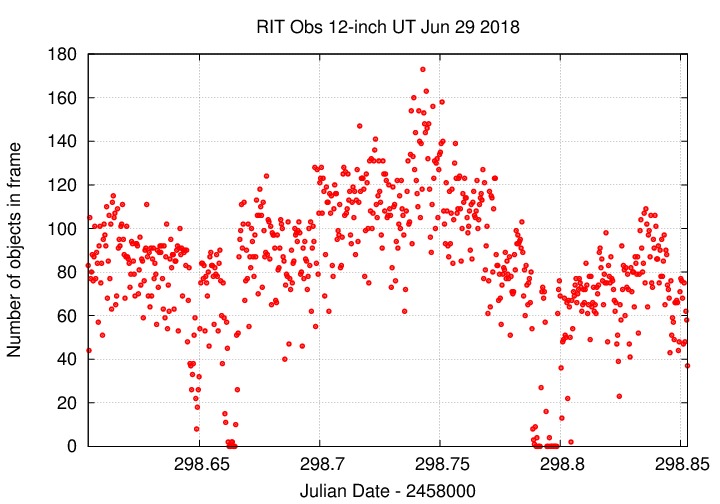
I used an aperture with radius 5.0 pixels. I adjusted the focus position from 0.842 -> 0.852 at midnight, then to 0.862 at 3:19 AM. The results are reasonable.

I discarded images which had obvious trailed stellar images, (151 of the 721 raw images).
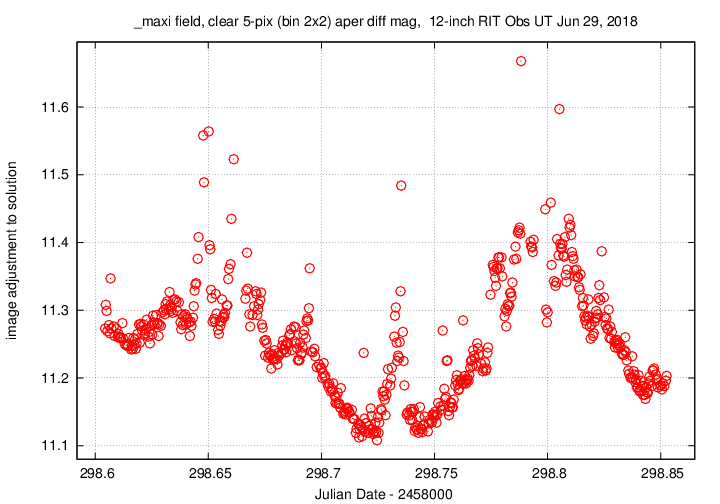
Using aperture photometry with a radius of 5 pixels (binned 2x2, each pixel is 1.34 arcsec, so a radius of 6.7 arcsec), I measured the instrumental magnitudes of a number of reference stars and the target. Following the procedures outlined by Kent Honeycutt's article on inhomogeneous ensemble photometry, I used all stars available in each image to define a reference frame, and measured each star against this frame.
Sigma-vs-mag plots show that the floor was about 0.008 mag overall, not too bad for such a bright, cloudy night. I marked star "A" as variable in the ensemble, as it was slightly saturated. The big outlier around instrumental magnitude 2.2 is MAXI J1820+070.
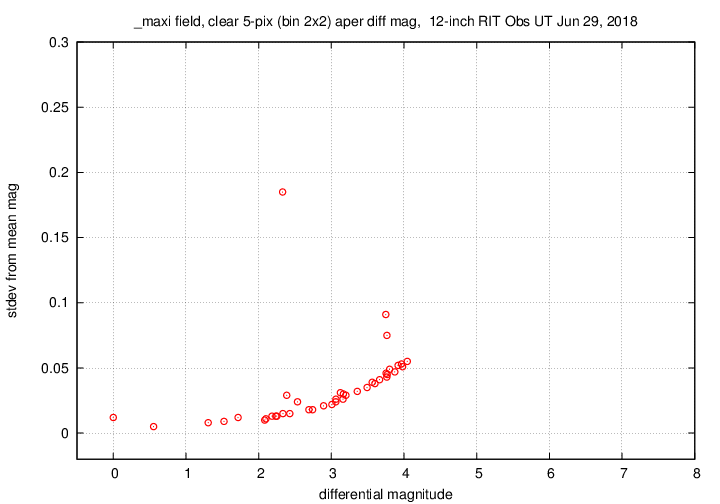
Here are light curves of the variable and the field stars.
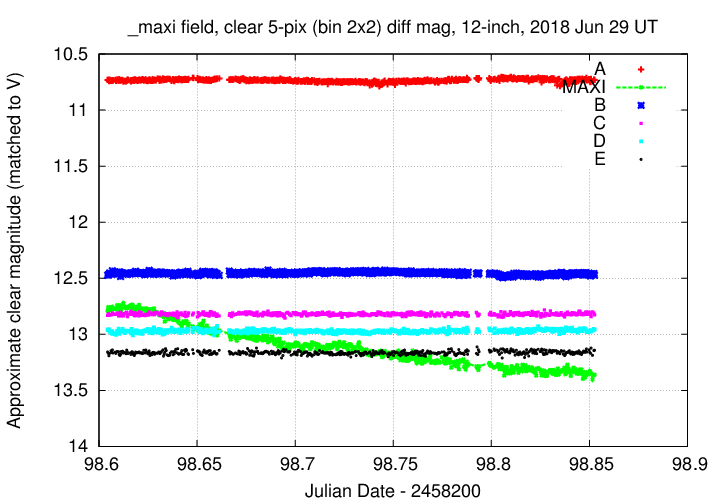
I used the UCAC value for the V-band magnitude of star "B" = UCAC4 486-079513 to shift the ensemble magnitudes to the standard V-band scale -- but remember that these are UNFILTERED measurements.
Here's a closeup on the variable. I'll connect the dots to make its behavior a bit easier to see. This time, our run coincided with almost the entire decline of the variable.
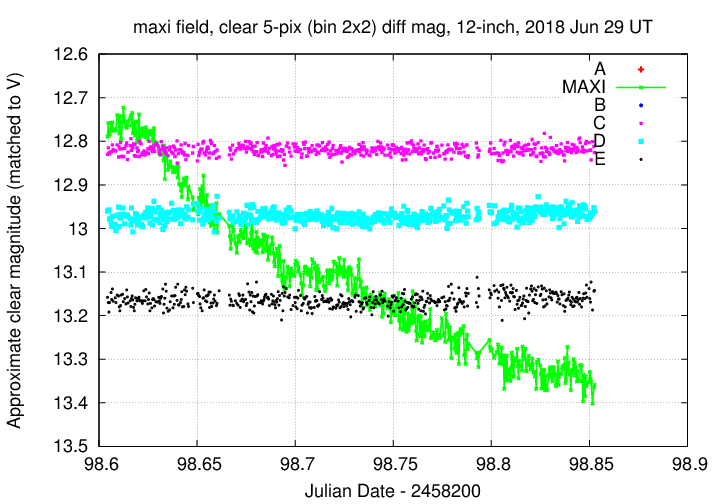
You can download my measurements below. A copy of the header of the file is shown to explain the format.
# Measurements of MAXIJ1820+070 made at RIT Obs, UT 2018 Jun 29, # in fair conditions, # by Michael Richmond, # using Meade 12-inch LX200 and ATIK 11000. # Exposures 25 seconds long, no filter. # Tabulated times are midexposure (FITS header time - half exposure length) # and accurate only to +/- 1 second (??). # 'mag' is a differential magnitude based on ensemble photometry # using a circular aperture of radius 5 pix = 6.6 arcseconds. # which has been shifted so UCAC4 486-079513 has mag=12.454 # which is its V-band magnitude according to UCAC4. # # UT_day JD HJD mag uncert Jun29.10438 2458298.60438 2458298.60944 12.789 0.012 Jun29.10472 2458298.60472 2458298.60978 12.758 0.013 Jun29.10507 2458298.60507 2458298.61013 12.778 0.013
Last modified 6/29/2018 by MWR.